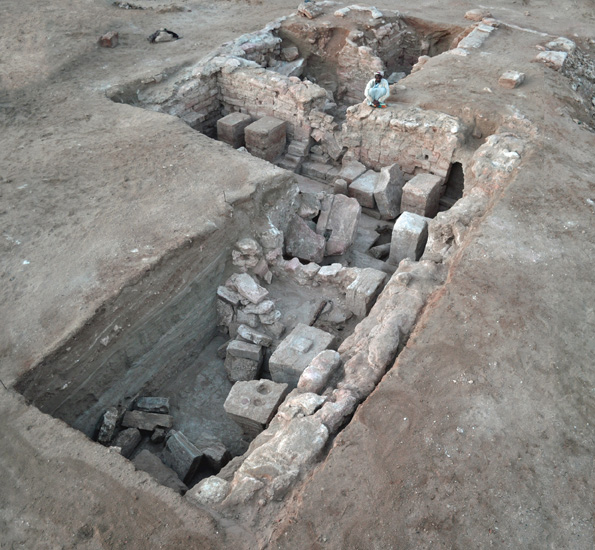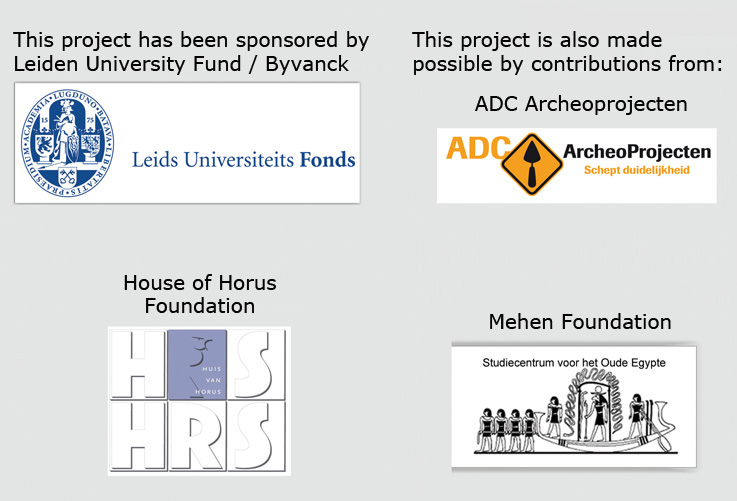This season, besides the continuation of the excavation of the inside of the temple building (trenches 112, 118) and the temple courtyard (trenches 111, 113, 119), work started on a site of what the magnetic map suggested had been the main entrance (propylon) to the temple proper from the east (trench 114).
Aside from the main entrance (the propylon) on the extreme eastern end of the temple there are three other portals leading from the courtyard. One is the main entrance to the temple building. This portal had already been excavated during the 2015 season; it preserved relief and carved decorations on either side of the entrance comprising lotus and papyrus plants and panels with figures of a king and deities. The second portal, at the northern end of the front wall of the temple building, leads into another portion of the temple.
Both of these doorways are similar in construction and have a threshold 20 cm high, the same as the height of the plinth the entire temple walls were built upon. The main entrance is 1.2 m wide, the northern entrance only 0.7 m. This northern entrance is directly in line with the doorway of the most northern room directly behind the roofed hall. This is maybe the sanctuary of a secondary god. The part of the room west of this door remained unexcavated in 2018.
A third door in the northern courtyard wall gives access to an another area within the temple temenos, containing workshops and storage facilities. Some of this area was already excavated before 2001 (trench 10).
Excavations produced abundant remains of temple wall and ceiling decoration, inscriptions and sculpture from the early Roman era. Also unearthed were more remains of the nineteenth century excavations. This consisted of several broken wine or beer bottles with corks, the leather sole of a boot complete with hobnails, the remains of a basket, fragments of glass and china, and a needle with thread still attached.
Preservation of the decoration on the door jambs between the two internal temple rooms is, in general, excellent in the lower courses of stone. At the base of the door jamb decorations comprised lotus and papyrus plants. The southern jamb in the door leading from trench 112 to trench 118 depicts a Roman emperor as pharaoh, presumably Caligula (reigned 37-41 AD), whose cartouches have been preserved at the top of the scene. He is shown offering to Isis of Koptos and her son Harpokrates. The right side is similarly decorated with an offering scene with the god Min of Koptos. The single bands of hieroglyphic inscriptions above the lotus and papyrus plants on both jambs preserves a text carved in Greek after the initial decoration had been applied. It records activities during the reign of the Roman emperor Titus (reigned 79-81 AD).

Overview of the excavations. On the foreground, a part of the courtyard is visible.
Trench 118, just west of trench 112 and connected by the decorated door jambs noted above, has walls with along the base decoration representing lotus and papyrus plants. Above this is a series of scenes with images of the pharaoh offering in front of two deities. The nineteenth century explorers reported seeing these scenes, but these were badly eroded even then.
In addition, there are decorations on the reveals of the door between trenches 112 and 118 that depicts groups of hieroglyphs with ankh (life) and was (dominion) signs, known as the ‘shadow of the door pattern’ because it would have been covered by the double wooden door leaves when open. Another door leads further west into the temple from trench 118 and its northern jamb contains hieroglyphs with part of a hymn to the goddess Isis. This door leads to the sanctuary. It is not excavated yet, but the nineteenth century explorers have recorded its reliefs in some detail.
Inscriptions fall into two broad categories: hieroglyphs and Greek texts. Both groups were primarily early Roman (first-second century AD) in date; there are also some texts of the early third century AD and, perhaps, one dating as late as the middle of third century AD. There were 18 Greek inscriptions, six of which indicate that the major deity worshipped in the temple was Isis. Although not mentioned in the inscriptions, sculptural remains both in the round and on altars (in the form of a large human foot) reveal that Serapis was also venerated in this temple. This combination of Isis and Serapis worshipped in one temple was common in Ptolemaic and Roman Egypt; in this temple Serapis was clearly the junior partner.
Many of the Greek texts that remain in situ were complete and were well dated from the first to the early third centuries AD. These and others were dedications to Isis, often for the completion of a successful voyage. Fragments of other monumental inscriptions, though not precisely datable, were likely also dedicated sometime during the first-second centuries AD. Two suffered damnatio memoriae (the name of the ruler had been deliberately destroyed): one dedicated to Domitian (reigned 81-96 AD). Some of the texts had been carved on columns.
Directly on the floor of BE18-112 a rectangular slab decorated with incised five-pointed stars was found. The slab preserved some greenish coloration perhaps indicating that the stars or, perhaps the spaces between the stars, were painted. The stone had fallen flat and face down on the soil. When lifted it gave a beautiful negative impression in the sand, which supports the hypothesis that the stars had not any inlay of stone or glass. It is similar to a small piece found in 2015 and a much larger roof block documented this year in trench 118. Another ceiling fragment with stars was found in the doorway between trenches 112 and 118.
Excavation in Trench 114 uncovered two substantial structures that were already visible in the magnetic data. , as Two columns in the forecourt are flanking the entrance of this gate structure. After an indeterminate amount of time, collapse debris from the southern forecourt wall and the pylons themselves accumulated in the immediate vicinity. This debris was followed by a thick deposit of windblown sand alternating with alluvial deposits. The upper layers here consisted of more recent natural and anthropogenic activity, including refuse left by archaeologists in the nineteenth century.
Excavations in trench 114 also recorded five inscriptions. Two of the texts remained in situ inside the entrance, providing a definitive width of the gate opening within the overall structure. In addition, excavations documented three statue fragments and one sun-disc carved stone from the collapse debris. Excavations here during the 2018 season, thus, confirmed the presence of a substantial gate giving access from the main street of Berenike to the temple courtyard.
